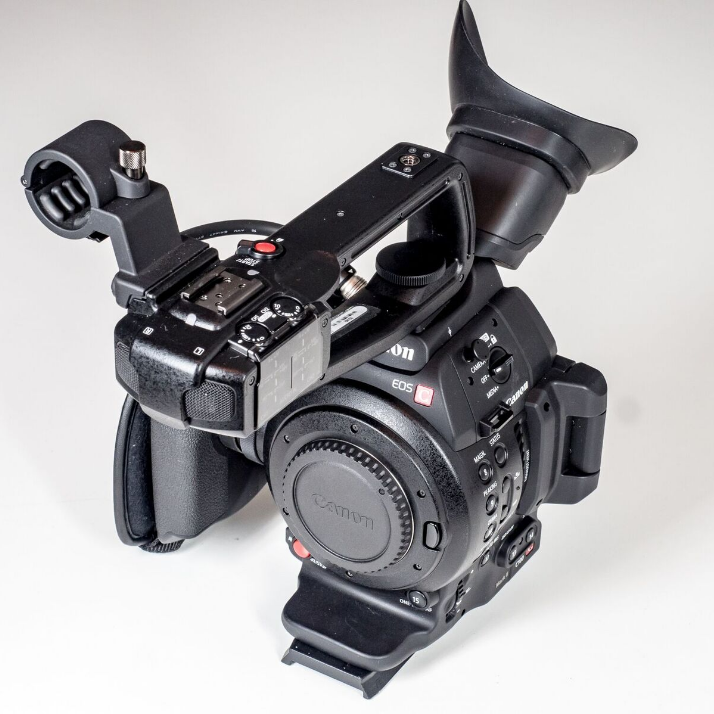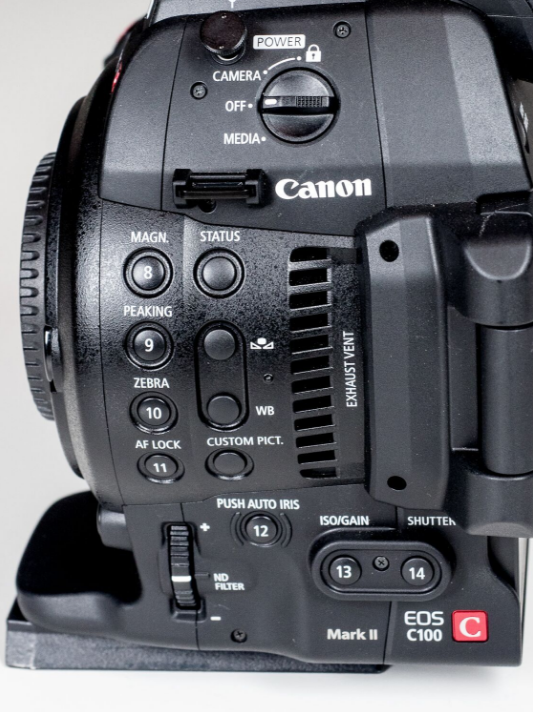Pictured above: The C100 Mk II in stripped down test configuration at the beach with the 70-200 F4.
The Canon C100 Mk II was released as the follow-up to the excellent C100 in early 2015. While the original camera was ground-breaking in its small size and terrific ergonomics, and quickly became popular as a news and online content camera, the MkII has been slower to find a market due to being a 1080 HD camera priced to compete with mainly new 4k cameras.
With Canon now introducing a terrific
$1500 rebate on the MkII, I thought it would be a great time to see if the baby of the Canon C-line of cinema cameras was value for money.
To do this I used it in the two primary ways the C100 will find work (and make its owner money). In a controlled interview situation, and as a run and gun documentary/event camera.
The interviews show off one the main features of the C100 MkII, and all the Canon C-line. The color science. IMO no-one outside of Arri gets skin tones as right as Canon straight from the camera. I filmed everything in Canon’s ‘Cinema’ mode which gives you a more low-contrast image that’s easy to grade and the subject’s skin just bloomed to life. With some of my other cameras, it can be a battle to get to this – no such problem with the C100 MkII.
(no audio below for legal reasons – trust me, its good!)
The MkII gives you a VIEW ASSIST mode that keeps the image nice and colorful in the EVF and LCD, and the button placement for focus magnification is in the right place on both the body and the side handle.
Audio via the XLR inputs on the top handle is clean and easy to adjust, and I like that there is a built-in stereo mic in the handle, and a mono mic built into the body for scrub audio or emergency atmos recording. Can be a lifesaver on a fast documentary shoot.
For the run and gun test, I went down to the old Muscle Beach and Pier in Santa Monica, with the camera cut down to its bare minimum (no top handle) and a Canon 70-200 telephoto lens, operating almost always at 200mm (300mm equivalent). All handheld.
I wanted to see how the dual-pixel autofocus functioned in real life, and how the camera felt in the hand for a couple hours.
The MkII is a solidly built camera. It feels very robust, even to how the buttons push in and the battery slot. I carried it ready to shoot for over 3 hours, and it also fitted perfectly in a medium backpack with the 70-200 attached. I used no other evfs or rigs.
[caption id="attachment_3119" align="aligncenter" width="700"]

The C300 Mk II with its detachable top handle.[/caption]
The dual-pixel autofocus of which Canon is justifiably proud works with almost all Canon lenses and is a revelation for shooting from the hip. See something you think might be interesting? Just pull it up and roll – the camera will find your focus for you. I was able to follow action as a solo shooter that I could not have done otherwise without a dedicated focus puller. It became quite addictive.
I filmed all the beach footage at 60F (59.94) to test the over crank possibilities of the Mk II. That’s a huge part of my personal style, and something clients love, and I had no issues with it. The built-in NDs were very helpful, and easy to use. Like the rest of the camera, they also feel strong and fell into place with a reassuring ‘thunk’.
[caption id="attachment_3118" align="aligncenter" width="524"]

The excellent C300 Mk II controls. Dedicated buttons![/caption]
The benefit of it being a mature HD camera (as opposed to 4k) is that I didn’t even have to think about either battery usage or SD card space (the Mk II has two slots which would cover the most demanding events). It's been some time since I could leave a camera in ‘ON’ mode for a full day without being on the verge of panic at the battery life!
So what do I think after my 2 days working with the C100 MkII? It's a very solid video camera, with a nice cinematic edge to it. The base iso of 850 means that it's very sensitive which is good for low-light shooting. Its primary weakness is the internal codec, which at a compressed 24mb is only about the same as a DSLR. In real life this isn’t much of a hindrance – most of the work that operators will do with this camera will be for non-network broadcast delivery, and the image is very gradable as is. You could add an external recorder if you must have a broadcast spec but I would have no problems shooting this camera for feature docs or even interview style commercials now. In fact, I know of at least one global content job I did this year this camera would have been perfect for.
But its real home, and where it would excel, is wedding/event coverage, or promotional mini-docs and behind the scenes shoots. At its new price, it would be a positive step up for a DSLR shooter with plenty of useful work life ahead of it.
PROS:
Ergonomics
Color science
Dual Pixel Auto Focus (with Canon lenses)
Works with EF-S and EF lenses.
Battery life
CONS:
Internal codecs
No ultra-slow motion
MARK TIERNEY d.g.a is an award-winning director/dop based in Santa Monica.
 The C300 Mk II with its detachable top handle.[/caption]
The dual-pixel autofocus of which Canon is justifiably proud works with almost all Canon lenses and is a revelation for shooting from the hip. See something you think might be interesting? Just pull it up and roll – the camera will find your focus for you. I was able to follow action as a solo shooter that I could not have done otherwise without a dedicated focus puller. It became quite addictive.
I filmed all the beach footage at 60F (59.94) to test the over crank possibilities of the Mk II. That’s a huge part of my personal style, and something clients love, and I had no issues with it. The built-in NDs were very helpful, and easy to use. Like the rest of the camera, they also feel strong and fell into place with a reassuring ‘thunk’.
[caption id="attachment_3118" align="aligncenter" width="524"]
The C300 Mk II with its detachable top handle.[/caption]
The dual-pixel autofocus of which Canon is justifiably proud works with almost all Canon lenses and is a revelation for shooting from the hip. See something you think might be interesting? Just pull it up and roll – the camera will find your focus for you. I was able to follow action as a solo shooter that I could not have done otherwise without a dedicated focus puller. It became quite addictive.
I filmed all the beach footage at 60F (59.94) to test the over crank possibilities of the Mk II. That’s a huge part of my personal style, and something clients love, and I had no issues with it. The built-in NDs were very helpful, and easy to use. Like the rest of the camera, they also feel strong and fell into place with a reassuring ‘thunk’.
[caption id="attachment_3118" align="aligncenter" width="524"] The excellent C300 Mk II controls. Dedicated buttons![/caption]
The benefit of it being a mature HD camera (as opposed to 4k) is that I didn’t even have to think about either battery usage or SD card space (the Mk II has two slots which would cover the most demanding events). It's been some time since I could leave a camera in ‘ON’ mode for a full day without being on the verge of panic at the battery life!
So what do I think after my 2 days working with the C100 MkII? It's a very solid video camera, with a nice cinematic edge to it. The base iso of 850 means that it's very sensitive which is good for low-light shooting. Its primary weakness is the internal codec, which at a compressed 24mb is only about the same as a DSLR. In real life this isn’t much of a hindrance – most of the work that operators will do with this camera will be for non-network broadcast delivery, and the image is very gradable as is. You could add an external recorder if you must have a broadcast spec but I would have no problems shooting this camera for feature docs or even interview style commercials now. In fact, I know of at least one global content job I did this year this camera would have been perfect for.
But its real home, and where it would excel, is wedding/event coverage, or promotional mini-docs and behind the scenes shoots. At its new price, it would be a positive step up for a DSLR shooter with plenty of useful work life ahead of it.
PROS:
Ergonomics
Color science
Dual Pixel Auto Focus (with Canon lenses)
Works with EF-S and EF lenses.
Battery life
CONS:
Internal codecs
No ultra-slow motion
MARK TIERNEY d.g.a is an award-winning director/dop based in Santa Monica.
The excellent C300 Mk II controls. Dedicated buttons![/caption]
The benefit of it being a mature HD camera (as opposed to 4k) is that I didn’t even have to think about either battery usage or SD card space (the Mk II has two slots which would cover the most demanding events). It's been some time since I could leave a camera in ‘ON’ mode for a full day without being on the verge of panic at the battery life!
So what do I think after my 2 days working with the C100 MkII? It's a very solid video camera, with a nice cinematic edge to it. The base iso of 850 means that it's very sensitive which is good for low-light shooting. Its primary weakness is the internal codec, which at a compressed 24mb is only about the same as a DSLR. In real life this isn’t much of a hindrance – most of the work that operators will do with this camera will be for non-network broadcast delivery, and the image is very gradable as is. You could add an external recorder if you must have a broadcast spec but I would have no problems shooting this camera for feature docs or even interview style commercials now. In fact, I know of at least one global content job I did this year this camera would have been perfect for.
But its real home, and where it would excel, is wedding/event coverage, or promotional mini-docs and behind the scenes shoots. At its new price, it would be a positive step up for a DSLR shooter with plenty of useful work life ahead of it.
PROS:
Ergonomics
Color science
Dual Pixel Auto Focus (with Canon lenses)
Works with EF-S and EF lenses.
Battery life
CONS:
Internal codecs
No ultra-slow motion
MARK TIERNEY d.g.a is an award-winning director/dop based in Santa Monica.





